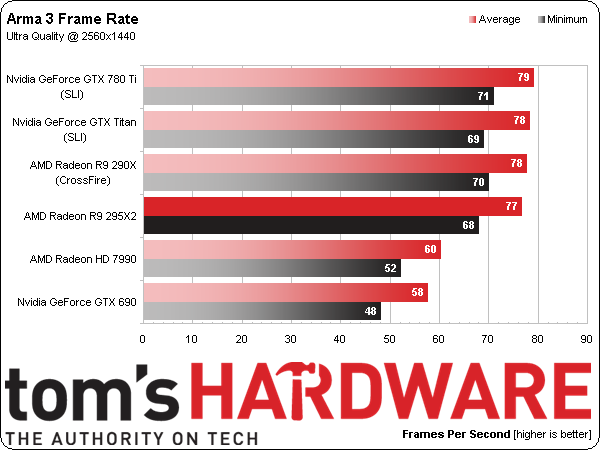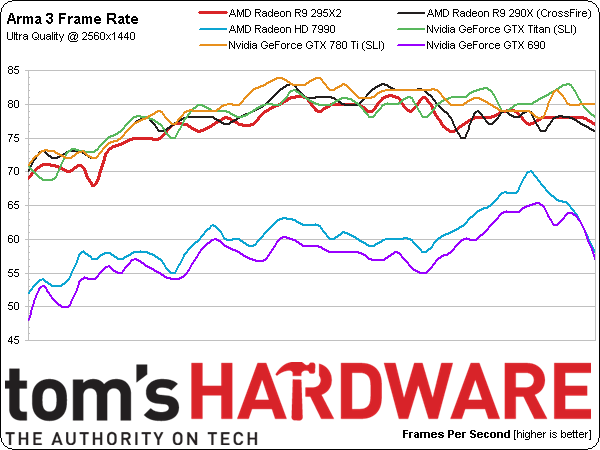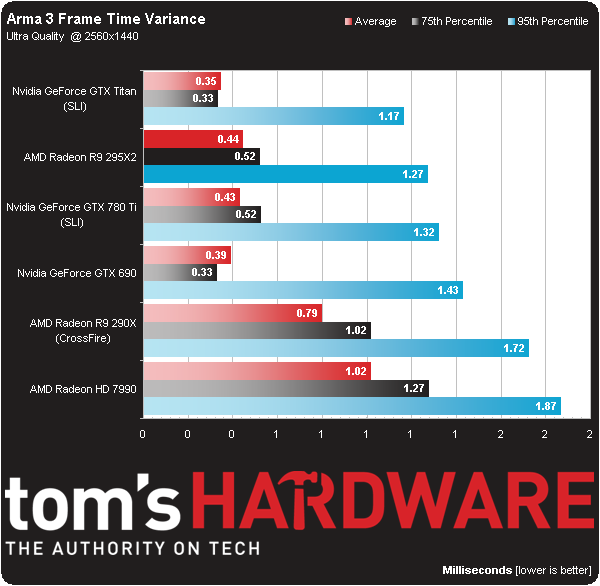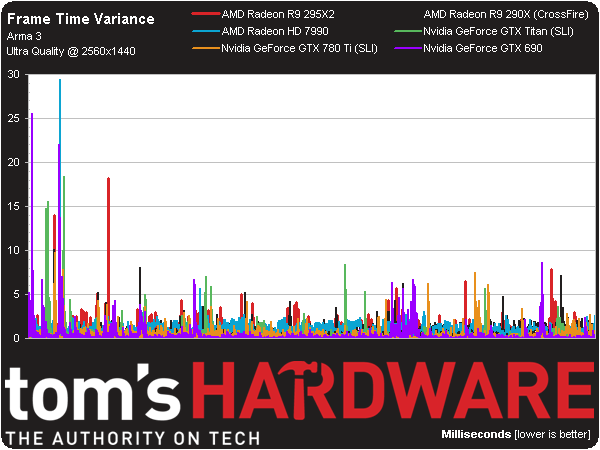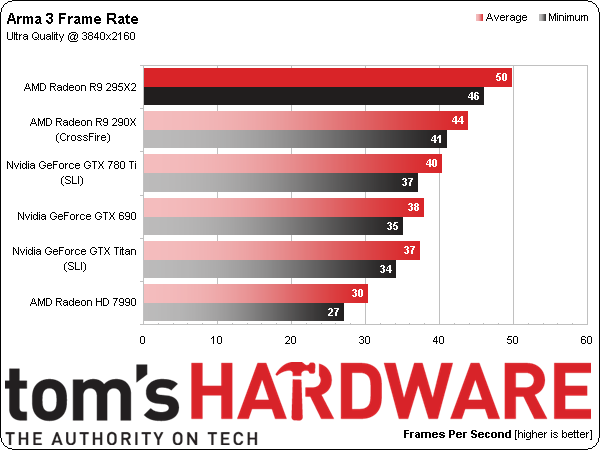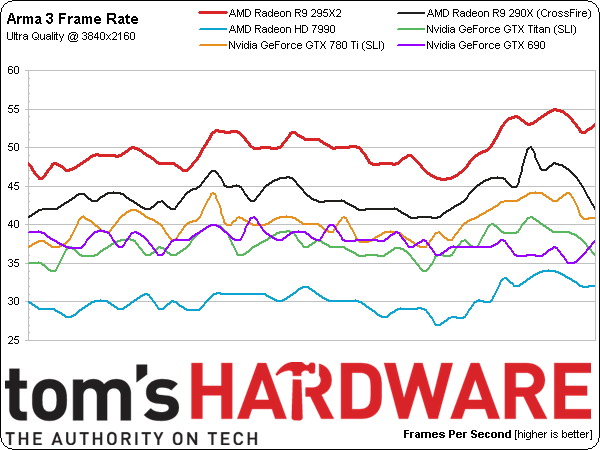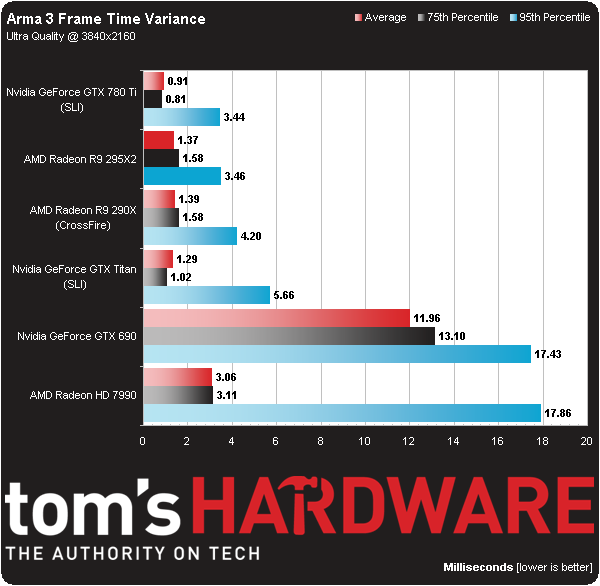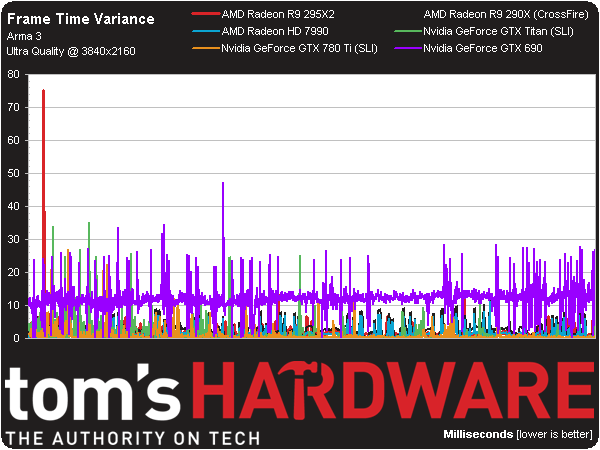Radeon R9 295X2 8 GB Review: Project Hydra Gets Liquid Cooling
“Do you have what it takes?” AMD asks, purportedly referring to the big budget and beefy power supply you need before buying its new Radeon R9 295X2. We benchmark the 500 W, dual-GPU beast against several other high-end configs before declaring a winner.
Results: Arma 3
2560x1440
AMD claims its Radeon R9 295X2 is designed for 4K gaming. But I also wanted to run 2560x1440. Not only is that resolution far more common in the high-end space, but it also serves as a good baseline before we get to the Ultra HD numbers.
Arma 3 demonstrates a platform bottleneck at 2560x1440, even with the game's lushest detail settings switched on. Average frame rates from most configurations hover just under 80, while minimums are just under 70 FPS.
Only the Radeon HD 7990 and GeForce GTX 690 fall short of the choke point, though both still deliver a readily-playable experience.
Charting frame rate over time shows the ultra-high-end boards in their narrow range up top, as the other two cards trail.
Frame time variance attempts to quantify the smoothness of a given graphics card’s performance. Once upon a time, not long ago, this was a very real issue for AMD in multi-GPU arrays. Its processors would deliver frames as they were made ready, sometimes resulting in runts—frames on-screen for so short of a time that you don’t actually perceive them.
The company first addressed concerns over reported versus experienced frame rates with a special driver that more evenly paced the rate at which output was displayed. And although the Radeon HD 7990 and Radeon R9 290X cards approach CrossFire differently, incredibly low frame time variance in Arma 3 shows that both solutions demonstrate effective pacing to keep variance low.
This sample of frame times reveals a handful of small spikes, but overall consistent performance.
Get Tom's Hardware's best news and in-depth reviews, straight to your inbox.
3840x2160
Gone is the bottleneck as we downshift to 3840x2160 and watch these cards further-differentiate themselves. The Radeon R9 295X2 sits up top, followed by two Radeon R9 290X boards in CrossFire. The GeForce GTX 780 Ti and Titans in SLI take third and fourth place.
Although we haven’t seen any dropped or runt frame issues from Nvidia in the past, two GK110s should easily best a pair of GK104s. However, Fraps and FCAT results seem to agree that Titans in SLI and the GeForce GTX 690 report similar average frame rates. What we’re likely missing is the fact that the 690’s 2 GB of memory per GPU causes quite a bit of stuttering. So, while the frame rate appears high through Fraps, the experience of gaming on a 690 at 4K is not nearly as pleasant.
That same phenomenon isn’t captured in the frame rate over time chart, where the GeForce GTX 690 appears quite quick. More notable is that the Radeon R9 295X2 is faster than the R9 290Xes in CrossFire, which in turn outperforms the two high-end combos from Nvidia.
The frame time variance at 3840x2160 is much higher than it was at 2560x1440, which we’d expect given significantly lower frame rates. However, all the way down to the Titans in SLI, even worst-case variance isn’t all that bad.
The GeForce GTX 690 registers significantly higher variance at Ultra HD. AMD’s Radeon HD 7990 runs into bad worst-case variance, while its average and 75th-percentile numbers are much more reasonable.
Current page: Results: Arma 3
Prev Page Test Hardware And Benchmarks Next Page Results: Assassin’s Creed IV: Black Flag-
Marsian Gustrianda Many people doubt about Dual GPU Hawaii will be Blow Up. It seems AMD really do well job. Nice Looking CardReply -
ohim This card is like the Veyron of WV , show the world what you can do (R295x2) but you`ll still relay on the sales of your WV Golf for revenue (270x, 280x)Reply -
outlw6669 Impressive performance, temperatures and fairly low noise!Reply
I would prefer a bit lower price, but this looks like a great card for the gamer that has everything! -
gunfighter zeck the name Dreadnaught originated from Dread Nothing or, fear nothing.Reply
Boss ship. -
Maxamus456 Hope this price stays low and not get bloated from bit con miners like its predecessors.Reply -
blubbey So let me get this straight. It runs pretty cool, quiet, performs well and (for the moment) is able to play a good selection of games at 4k admirably and is priced competitively. Plus if you are going to drop a bit more on watercooling your GPUs (which is a possibility if you're spending $1200+) that gives this card even greater value. Nice work AMD.Reply -
marciocattini Wheres Tom's Hardware seal of approval? =( clearly this card diserves some love!Reply
